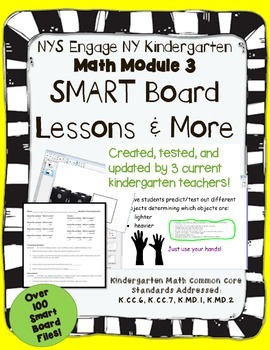Engage NY Kindergarten Math Module 3 SMART Board and More!
Rrrerin2Learn
930 Followers
Grade Levels
PreK - K
Subjects
Resource Type
Standards
CCSSK.CC.C.6
CCSSK.CC.C.7
CCSSK.MD.A.1
CCSSK.MD.A.2
CCSSK.MD.B.3
Formats Included
- Zip
Pages
N/A
Rrrerin2Learn
930 Followers
Description
Engage NY Math Module 3 Smart Board Lessons, Application Problems, Pacing Guide and Modified Assessment!
Included in the set:
-Over 100 SMART Board files covering the main content of the lessons and fluency activities as separate files to give you flexibility!
-All application problems in an easy to print packet for each student
-All application in a SMART Board file for easy modeling
-Pacing Guide to see our modified lesson structure to help us get to all content in the year. The guide also includes how we have modified the module to include the Exit ticket routine established in Module 1
-Modified Post- assessment that gives you the information you need in a clearer/easier way than the current module.
Check out a few Smart Board Files for free:
Module 3 Freebie Lesson and Fluency for Smart Board!
Purchase just the extras or just the lessons at a lower price!
Module 3 Just the Smart Board Lessons!
Check out my other Full Sets Available Now in my store!
Here is a great resource to engage learners during whole group!
Laptops are better than a whiteboard and so easy to make!!
Included in the set:
-Over 100 SMART Board files covering the main content of the lessons and fluency activities as separate files to give you flexibility!
-All application problems in an easy to print packet for each student
-All application in a SMART Board file for easy modeling
-Pacing Guide to see our modified lesson structure to help us get to all content in the year. The guide also includes how we have modified the module to include the Exit ticket routine established in Module 1
-Modified Post- assessment that gives you the information you need in a clearer/easier way than the current module.
Check out a few Smart Board Files for free:
Module 3 Freebie Lesson and Fluency for Smart Board!
Purchase just the extras or just the lessons at a lower price!
Module 3 Just the Smart Board Lessons!
Check out my other Full Sets Available Now in my store!
Here is a great resource to engage learners during whole group!
Laptops are better than a whiteboard and so easy to make!!
Total Pages
N/A
Answer Key
N/A
Teaching Duration
2 months
Report this resource to TPT
Reported resources will be reviewed by our team. Report this resource to let us know if this resource violates TPT’s content guidelines.
Standards
to see state-specific standards (only available in the US).
CCSSK.CC.C.6
Identify whether the number of objects in one group is greater than, less than, or equal to the number of objects in another group, e.g., by using matching and counting strategies.
CCSSK.CC.C.7
Compare two numbers between 1 and 10 presented as written numerals.
CCSSK.MD.A.1
Describe measurable attributes of objects, such as length or weight. Describe several measurable attributes of a single object.
CCSSK.MD.A.2
Directly compare two objects with a measurable attribute in common, to see which object has “more of”/“less of” the attribute, and describe the difference. For example, directly compare the heights of two children and describe one child as taller/shorter.
CCSSK.MD.B.3
Classify objects into given categories; count the numbers of objects in each category and sort the categories by count.





